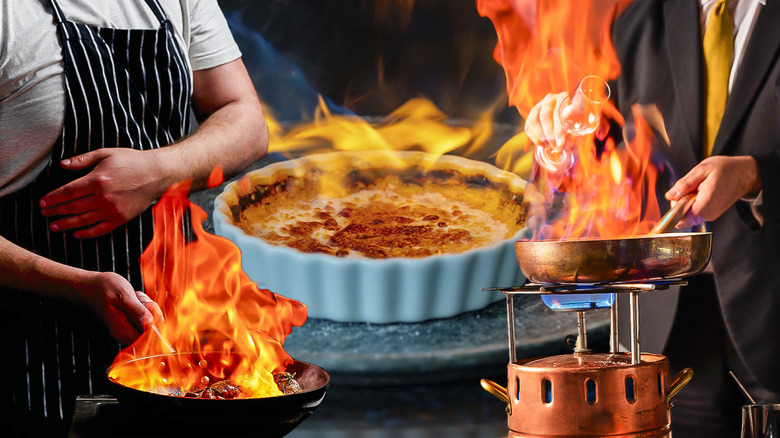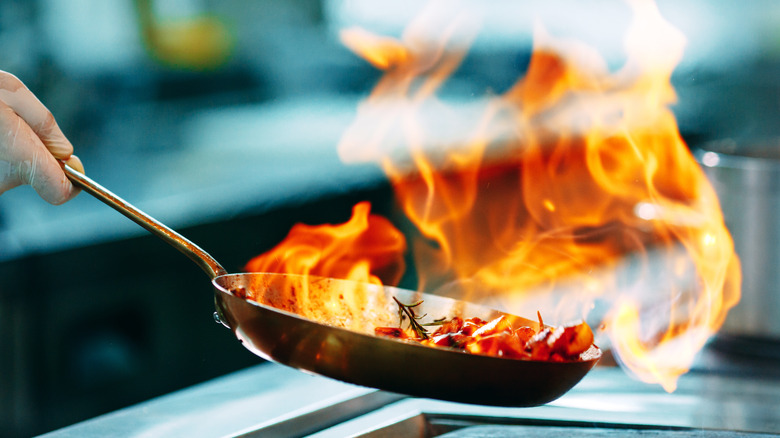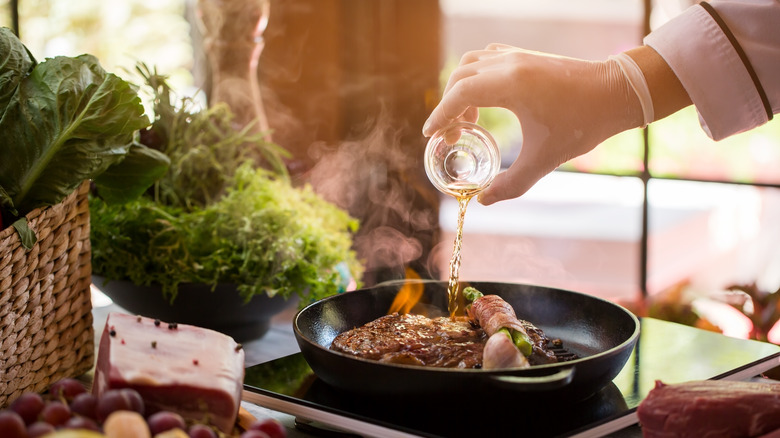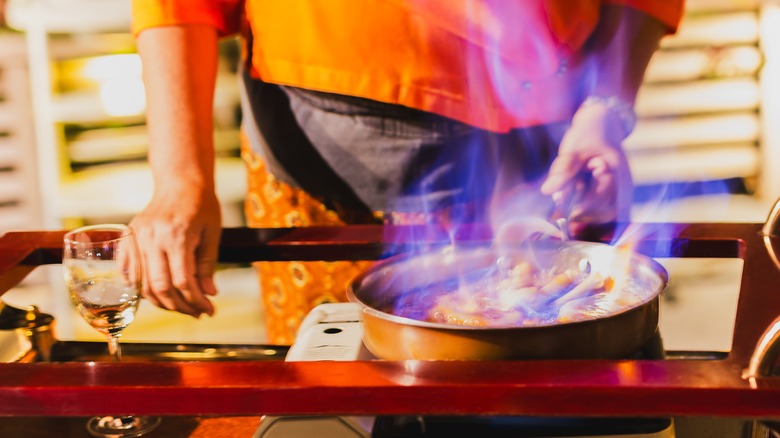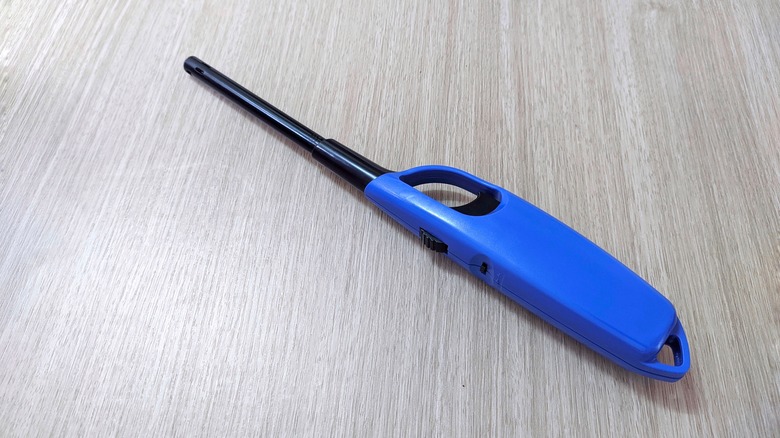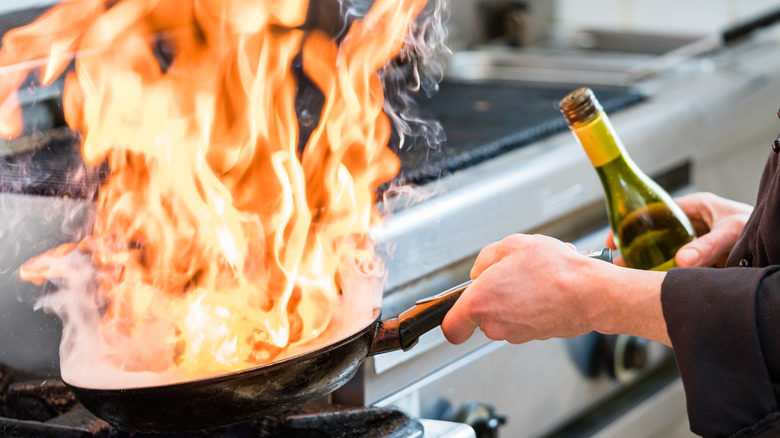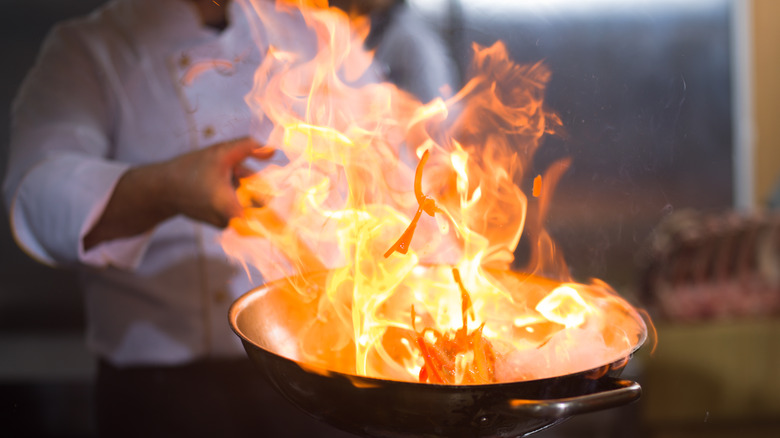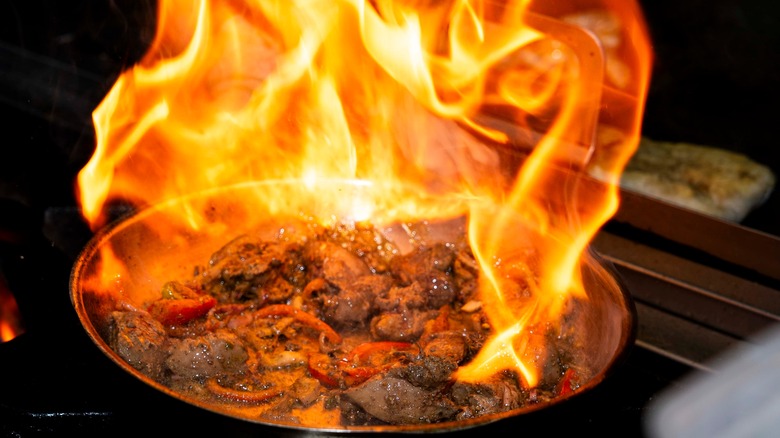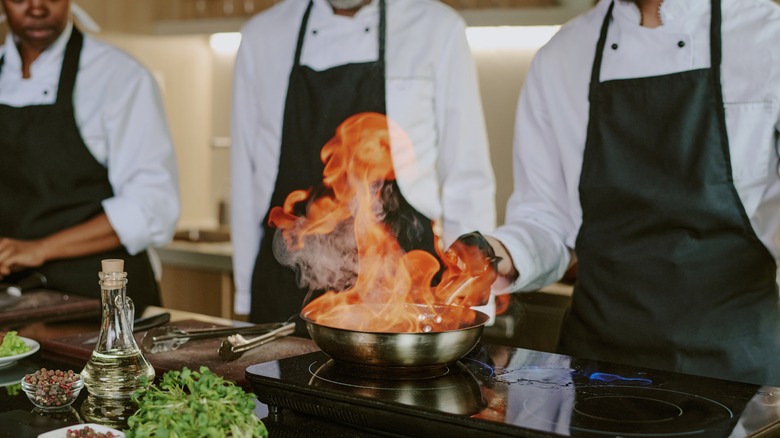8 Tips For Flambéing Dishes Like A Professional Chef
Bananas Foster, baked Alaska, crêpes Suzette – all of these desserts have two things in common. They're all delicious, and they're all known for their fiery table-side presentations. Whether you're on a cruise ship or in a fancy restaurant, watching a chef or waiter add alcohol to a pan or dish and then light it on fire is a sight to behold.
As a classic cooking technique, flambé has been around a lot longer than you might think. French for "flamed," flambéing is not done just for the fun spectacle it creates. The alcohol adds flavor to your dish, and the ingredients in the pan get the bonus of some caramelization from the flames.
My first flambé experience was in culinary school, where our kitchen classroom was full of newbies who scorched bananas soaked in rum and brown sugar so badly the smoke alarm went off for what felt like hours. Since then, I've mastered the art of flambéing, using the technique on everything from desserts to savory dishes like coq au vin. Despite appearances and what you might think, you can flambé at home like a professional chef without causing a three-alarm fire. These tips will ensure you get it right.
Not all pans are flambé worthy
Choosing a pan to flambé in is not as simple as you might think, because not just any pan will do. There are two important things to consider before you grab the matches — the materials your pan is made of, and keeping yourself and your kitchen safe and burn-free. When it comes to picking the right pan for flambéing, it's important to choose one that can safely withstand high heat. Skip the aluminum and nonstick pans and reach for stainless steel or cast iron. Nonstick pans might seem like a smart choice to prevent sticky, sugary sauces from sticking once they're flambéed, but nonstick coatings aren't built for the high heat that comes with flames. Flambéing can damage the nonstick coating and cause the pan to leach toxins into your food.
You should also choose a pan with a long handle that's also fireproof. This will allow you to keep a firm grip on the pan while keeping your distance from the flames. When I taught cooking classes where flambéing was on the menu, I always chose pans that were on the large side, so students had plenty of room to flambé without worrying about the alcohol or the flames spilling out of the pan.
Pick the right alcohol
Before you can flambé, it's imperative that you understand a few terms related to alcohol. If you aren't familiar with the terms "alcohol by volume" and "proof," you could choose a spirit that won't produce the flames you're looking for or one that could be dangerously flammable. Choosing just the right alcohol is key to flambéing for the best tasting and safest results.
Alcohol by volume is used to measure a beverage's alcohol content. It lets consumers know exactly what percentage of the beverage is alcohol. Proof is another term used to indicate how much alcohol a beverage contains. To determine a drink's proof, simply double its alcohol by volume. So if an alcohol is 80 proof, you know that its alcohol by volume is 40%.
Proof is important when selecting an alcohol to use in recipes that are flambéed. You'll need alcohol that is at least 80 proof (40% alcohol by volume). Anything less, and there isn't enough alcohol present to ignite. On the other hand, you should avoid alcohols that are 120 proof or higher. This much alcohol is dangerously flammable. Spirits like cognac, rum, brandy, and bourbon are safe and popular choices.
Get the alcohol amount and temperature right
More is not always better in the kitchen, and that is especially true when you're flambéing. You might be tempted to pour more of your alcohol of choice into your pan in order to produce a larger, more impressive flame, but that can create a dangerous situation. You want to add just enough alcohol to ignite, and no more. I've watched novice cooks add too much alcohol to pans only to end up with massive flames that leapt from the pan and dishes that tasted only of alcohol. Fire hazard aside, too much alcohol can overpower the other flavors in your pan. Using 1 to 3 ounces of alcohol, or 1 tablespoon for each serving of your dish in the pan, are good rules of thumb.
The temperature of the alcohol is also important when you're flambéing. If your alcohol is cold, you won't be able to light it. Heat it just until tiny bubbles begin to form around the edges of the pan before adding it to your other ingredients. If you have a thermometer on hand, use it to determine when your alcohol reaches 130 degrees Fahrenheit, which is the ideal temperature. You can gently warm the alcohol on the stovetop or in the microwave for 30 to 45 seconds. Whichever method you choose, be careful not to bring the alcohol to a boil. Boiling will cause it to evaporate, and it won't ignite.
Use a long match or lighter
The goal of flambéing is to ignite the alcohol so that it produces showstopping flames and adds a delicious depth of flavor to your dish. A successful flambé gives you the visual flash and flair without causing injury to you, your kitchen, or your guests. One way to ensure your success is to choose the right tool to light the alcohol in your pan. If you've seen TV chefs flambé, you've likely witnessed them adding alcohol to a pan and then tipping the pan ever so slightly so that the liquid in the pan spills over the side and hits the flame underneath. As dramatic as this might appear, it's dangerous to attempt this at home.
For the safest and best results, skip the pan tip and use a long safety match or a long utility lighter. Regular matches require you to get too close to the flame, increasing your risk of burning yourself. The extra length allows you to keep your hands safely away from the flames and still get the job done.
Play it safe
Playing it safe when flambéing is critical to preventing accidents in the kitchen. Alcohol and open flames can be a precarious combination, and even a small mistake can lead to a dangerous situation. Fortunately, there are simple steps you can take to make flambéing safe for your kitchen. One key safety measure is keeping a lid that fits the pan you're flambéing in nearby. In the event that your flambé gets out of control and your flames are too large, you can simply put the lid on the pan to smother them. By covering the pan quickly, you can extinguish the flame safely.
Another way to prevent mishaps is to remember that when flambéing a dish, never pour booze straight from the bottle into the pan. You've probably seen cooking show chefs do this for dramatic effect, but besides running the risk of adding too much alcohol to your pan, this can also cause an explosion. You read that right! If the pan is too hot when you pour the alcohol in, that excess heat can cause the alcohol to ignite without you lighting it. The flames can follow the stream of alcohol back into the bottle, causing the bottle to explode. Instead, measure out the amount of alcohol you need in a separate container before heating it and adding it to the pan.
Have your ingredients ready and set
At the top of every cooking class I teach, I share a very important pre-cooking ritual with my students. I talk at length about the importance of mise en place. Mise en place is a simple technique that will help you prep and cook like a pro. It's the process of assembling and preparing all of your ingredients as they're needed in your recipe before you start to cook. It streamlines your cooking process, allowing you to focus fully on cooking instead of trying to prep and cook at the same time. Mise en place is especially important when you're flambéing dishes.
Flambéing moves quickly. Once you add the alcohol to the pan, there's no time to wait to assemble or prepare the ingredients. Before and after the flame is lit, it's imperative that your full attention is on what's happening in your pan. If you add the alcohol and don't proceed immediately, the food will absorb the booze before you can ignite it. Mise en place doesn't just refer to your ingredients; you also want to make sure you have all the tools you need on hand, too.
Take the pan off the heat before flambéing
This next bit of flambéing advice might seem counterintuitive, but it's another safety precaution that will ensure you complete your recipe without burns or causing a fire. Before you attempt to add the alcohol to your pan or ignite it, remove the pan from the heat on the stove. Even though you need heat to complete the flambé, you don't want the heat coming from both your burner and the match or lighter you're using. You can either turn off the burner when flambéing in a pan, or move the pan to a burner that is turned off, but it's imperative that the heat source is no longer active before you flambé.
Removing the pan from the heat will help you prevent accidents and help keep you from burning yourself. It also gives you more control over the process. You can ignite the alcohol safely without concerns about the heat or flame from the stove igniting it accidentally before you're prepared. When I flambé at home, my gas burner extinguishes instantly, but if you're using an electric oven, turning off the burner won't lose heat immediately, so carefully slide your pan to another burner that is not hot to flambé.
Remember that not all of the alcohol burns off
Contrary to popular belief, all of the alcohol doesn't completely burn off when you flambé. This is important to keep in mind if you're serving children or adults who don't consume alcohol. A portion of the alcohol does burn off when it's flambéed, but some is left behind to add the distinct flavors of your alcohol of choice to your dish. However, many cooks believe a quick flambé removes all of the alcohol added with only the flavor remaining. The amount of alcohol that burns off can vary greatly depending on how long the dish is cooked and the size of your pan.
In most cases, when dishes are flambéed, they retain about 75% of the alcohol added. Only about 25% evaporates away with the flames. If you managed to flambé your dish for 15 minutes, 40% of the alcohol would remain in your pan. This is another reason why it's crucial that you pay close attention to the amount of alcohol you use.
Pan size can also affect the amount of alcohol that burns off. A wider pan provides additional surface area, making it easier for more of the alcohol to evaporate away.
